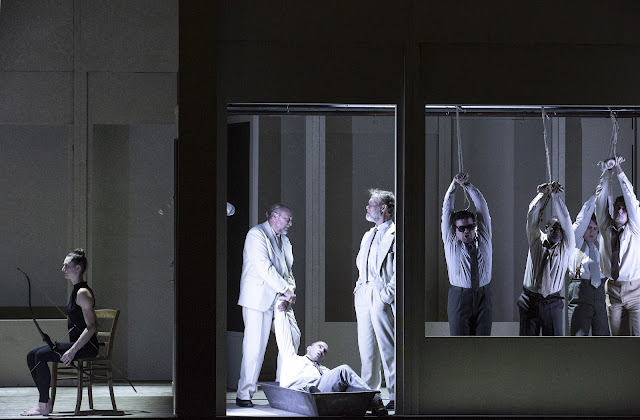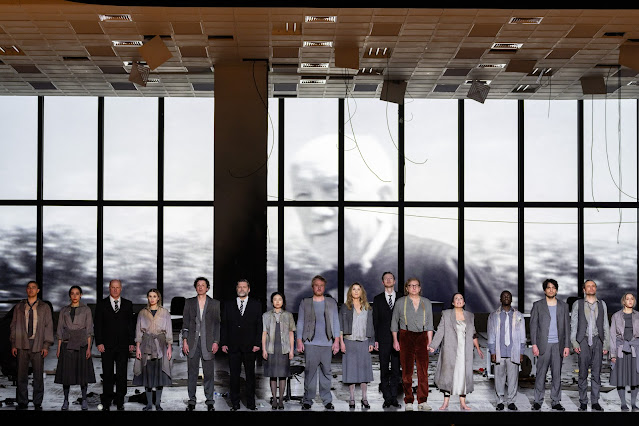If I remember correctly, that splendidly
grumpy old man Johannes Brahms averred that he would much rather stay at home
and read the score than suffer yet another Don Giovanni disappointment
in the opera house. Often, one sympathises—and more generally with Mozart,
especially nowadays. It is, notoriously, a director’s graveyard; it has
for a while also seemed to be a conductor’s graveyard too. In both cases, the
Commendatore regularly calls time on all manner of easy perversities that too
often masquerade in place of understanding, hard work, and genuine imagination
and invention. I was nonetheless keen to see this new Aix production, the
festival’s eighth and my first there. That was above all to see what Robert
Icke, an almost universally admired figure of British spoken theatre – this
season alone, I saw Oedipus and Manhunt (which Icke wrote as well
as directed) – might accomplish in his first foray into opera.
Having entered the theatre and quickly
skimmed a page or two of the programme, I felt my heart sink when I read some
of Simon Rattle’s words in the programme, regardless of the good sense many
others made. ‘The “Mozart” [!] I grew up with as a child – the style of
interpretation I once admired – has, for most of us, become unlistenable. We’ve
all evolved without realising it.’ Perhaps, then, this would be a classic
instance of one element working and one distracting, with the stage
performances themselves as yet undetermined. For once, alas, my inner Brahms
proved wrong. There was much to admire and to consider on all fronts. Not only
was this to be a serious piece of theatre; it was, certain, despite inevitable
reservations, to be the best Mozart and indeed to my taste probably the best performance
of music before Wagner I had heard from Rattle. This, I think, was testament not
only to his thoughtful, keen-eared approach, dismissal of Furtwängler, Böhm, Klemperer,
Giulini, Davis, et al. (and their admirers) notwithstanding, but also to
willingness to learn from his still relatively new orchestra, the Bavarian
Radio Symphony, and to theirs from him.

Interviewed in 2015, Icke declared his
responsibility ‘always’ to be ‘to the impulse of the original play, to clear
away the accumulated dust of its performance history. So much of great drama
was profoundly troubling when it was first done. They rioted at Ibsen’s A
Doll’s House, for goodness’ sake. Audiences shouldn’t be allowed to feel
nothing.’ A ‘period’ approach similar to Rattle’s (at least in theory, if not
in practice)? Hardly, as anyone familiar with his work would attest. That is,
in part, the problem: such notions mean such different things to people in
different contexts that misunderstanding – doubtless including mine concerning
Rattle’s words – is rife. Enough, anyway, of this preamble. It may have been
better to plunge straight into the action as Mozart does, if arguably to
withdraw a little thereafter. I wanted, though, to try to give an impression or
at least a self-assessment of my own accumulated dust, if only to help explain my
own admiration – some anticipated, some less so – for what I saw and heard.
Icke opens with the Commendatore, in a
sense master of ceremonies, initiating his own private performance—on record,
like so many of us, one might even say in neo-Brahmsian fashion. The sounds of
an old, crackly performance will be heard again for Giovanni’s Tafelmusik
as we approach the denouement and the Commendatore’s return. (In reality, he
has never been away, conceptually or physically, as stage appearances make
clear.) For there is here a strong relationship, probably identity, between the
two. Does Giovanni’s murder of his nemesis thereby suggest the master of his
own fate is indeed his own nemesis? Is the action that unfolds, whether from the
standpoint of an old man sipping wine to a gramophone record of his youth or
from hospital bed and a fatally wounded young man, drip-attached, staggering
with increasing difficulty across the stage (n the second act), the
Commendatore/Giovanni narrating his own story? How reliable a narrator might he
be? And how reliable might live and recorded video images be? The work, even? These
are not necessarily questions to be answered definitively, though nor are they trivially
raised then neglected. This is – at least was for me – a call to active participation
from the spectator and listener. That may be why some evidently did not care
for it.
The concept takes its leave, I think, from
Leporello’s line, ‘Chi è morto, voi, o il vecchio?’ To ask his master who is
dead, him or the old man, is generally taken not only to be (theatre of the) absurd
– clearly it is – but as merely silly. (Thank goodness this was not a Don
Giovanni played ‘for laughs’, a dramaturgical misunderstanding of the
highest or rather the lowest order. The ever-irksome Glyndebourne guffaw was at
least avoided.) If we lose the intrinsic master-servant dialectic, highly
eroticised by Giovanni’s clothes- and partner-swapping libertinism, we gain an
intriguing consideration of what relationship there might be between Giovanni
and the Commendatore and what their secret(s) might be. Occasional sharing of
lines between characters, not only them, speaks and sings of other connections,
born of theatrical experience – they work to the extent one might not even
notice – and possibility. It is a standpoint; no one would claim it to be the
only standpoint, but it is a fruitful one.

For we rarely ask who the Commendatore is.
We arguably do not even ask who Giovanni is, though we think we do. His kinetic
energy deludes, seduces us—as well as those onstage. There are neither
masquerade nor masqueraders here, which is surely part of the point. Instead, the
old man – or is it the young man – has summoned characters from the medical
staff. Donna Elvira, the young man’s fellow inhabitant of the chameleon-realm
between seria and buffo, di mezzo caraterre, is notably precisely
who she says she is, her words generally disregarded: his wife. In the final
reckoning, she returns to his bedside. Perhaps he is not dead after all, then:
not in a banal, realistic way so much, but rather to reckon with the
circularity of an abuse that is born of and returns to the family, a little
girl who sees it all the counterpart, perhaps more than that, to Donna Anna. As
survivors do – are we all, ‘in a very real sense’, survivors? – she teaches
other women, onstage and on film. She should not have to, of course, but what
choice does she and do they have?
The idea of standing between life and death
– in limbo perhaps or hell, even heaven – can be considered and expressed in
many ways. Giovanni’s initial, disconcerting beatific gaze suggests one way,
perhaps not taken—or is it? At any rate, the idea is one arguably explored in
the work or at least one it might encourage us to explore. Claus
Guth’s Salzburg production was admired by many, though it struck me as in
many ways problematical—not least since it took the cowardly, decidedly non-Giovanni
path of omitting the scena ultima. When I think about it again, though,
it certainly occupied itself with this notion. Here, the heartbeat that
punctuates the action – filmic yet theatrical, auditory yet visual – brings it
home arrestingly, in more than once.

Use of surtitles to convey concept rather
than the text is by now a common dramaturgical device. Here, I admit I felt
unease: was too much being skated over? Might not the conflict have been better
brought out into the open? Did the ‘new’ words for the scena ultima
threaten ironically to turn what we saw into too much of a conventional
morality play? Perhaps that was the point; if so, it seemed a pity, also a
little too much ‘leading’ for what we ought to have been able to grasp without.
At least, though, I was led to ask the question, and it may have been my
misunderstanding or simply a case of my preference/preconception not according
with a valid alternative.
Rattle’s musical dramaturgy surprised me:
not only from what he had said, but from what I had been told. A friend who had
attended an earlier performance informed me of swift tempi. Once past a
shockingly fast alla breve, even by current standards, what I heard was
anything but. Who knows? Maybe I too am an ‘authenticist’ without having known
it. The point was not of course speed or even tempi as such, but rather a
variegated approach, giving each number its due whilst attempting to situate it
within a greater whole. I did not find everything entirely convincing; when
does one ever? More often than not I did, though. I also found a welcome
collaborative approach not only to the production but to the cast, without ever
falling into the messy trap of having them all do their own thing. This work
needs a musical as well as a stage director—and it received one: one, moreover,
who was as alert as any I have heard, perhaps even more so, to the array of
timbral possibilities, some historically derived, some less so. The Munich wind
in particular must have thanked their lucky stars.
The whole orchestra was on
outstanding form, truly able to ‘speak’ dramatically: a quality Rattle
associates with Nikolaus Harnoncourt and which I do with Mozart’s position
between Gluck and Mozart. Again, maybe we are not so far apart after all; maybe
we are ready at long last to put such ‘debates’ behind us. There were times when tension sagged a little, Rattle perhaps savouring, even loving, the score more than is ideal, however understandable. As ever, the familiar conflation of Prague and Vienna versions did not help. (For once, given aspects of the production, inclusion of the Leporello-Zerlina duet might have been an advantage.) But none of my reservations was grievous and I learned much from what I heard too.

Andrè Schuen proved an outstanding Giovanni:
properly adaptive to every situation, his very core shifting as necessary; suave
and strong; yet troubled and tortured. Clive Bayley’s Commendatore, unusually and
necessarily more acted than sung, imparted equal conviction in the concept. If
(the mature) Donna Anna seemed somewhat sidelined by that concept, Golda
Schultz’s vocal palette and sparkle left nothing to be desired. Krzysztof
Bączyk was likewise faced with a production in which Leporello seemed less
central than otherwise, but his performance remained estimable, a proper foil
to his master’s (in either incarnation). Magdalena Kožená fully captured the
world of a different Elvira, words and music harnessed with insight. Madison
Nono and Paweł Horodyski presented a spirited, finely sung Zerlina and Masetto with an apt taste
for light sadomasochism that was not confined to them. Amitai Pati seemed at times a little out of sorts vocally
as Don Ottavio, but everyone is entitled to a (relative) off-night, especially in such cruelly exposed music. All the
cast, small chorus included, contributed to the realisation of the greater
whole: Icke’s, Rattle’s, and the broad intersection of the two.





























